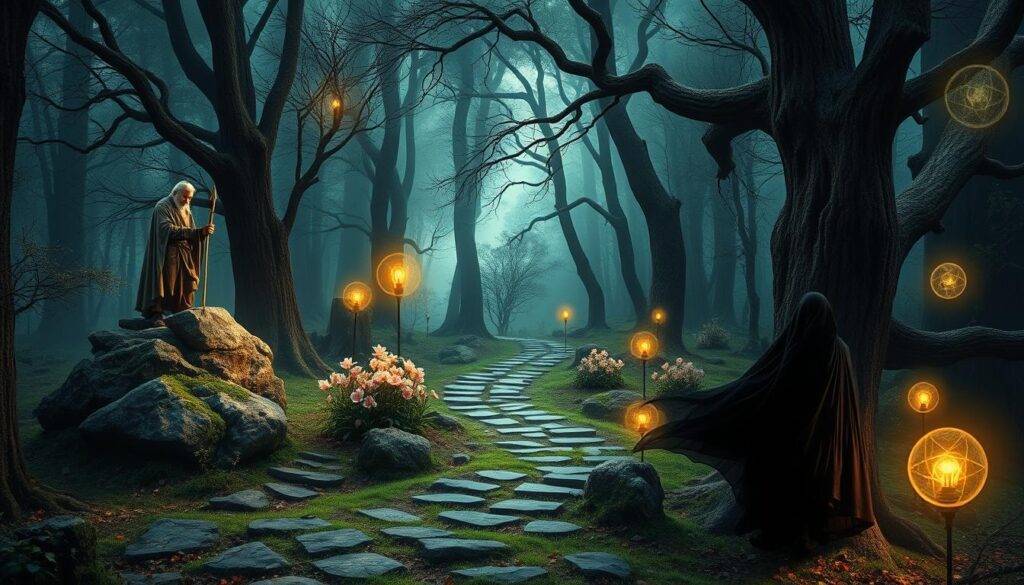“The meeting of two personalities is like the contact of two chemical substances: if there is any reaction, both are transformed.” – Carl Jung
Mythic archetypes are shared human experiences and values. They appear in myths from all over the world. These include the Hero, the Villain, the Mentor, and the Trickster. Each archetype teaches us important lessons about right and wrong.
As you explore yourself, learning about these archetypes can reveal a lot about you. It can help you grow and understand yourself better.
Key Takeaways
- Archetypes are universal symbols and patterns found in human narratives and experiences.
- Understanding archetypes can provide valuable self-knowledge and facilitate personal transformation.
- Mythic archetypes like the Hero, Mentor, and Trickster are found in stories across cultures and religions.
- Jungian psychology explores the collective unconscious and its role in shaping human behavior and decision-making.
- Integrating archetypal wisdom can enhance your decision-making, problem-solving, and overall well-being.
Understanding the Power of Archetypes in Human Psychology
Archetypes are symbols and characters that shape our behavior and psychology. They were first introduced by Carl Jung. These archetypes are part of the collective unconscious, a shared part of our psyche.
Origins and Evolution of Archetypal Theory
The idea of archetypes comes from ancient Greek philosophy. The word “archetype” means “original pattern.” These symbols and figures appear in stories and myths worldwide, showing common human experiences.
The Collective Unconscious Connection
Archetypes show up in dreams, art, and religion, guiding our actions and thoughts. They help us understand the human condition and the core of our Personality Types.
Impact on Modern Psychology
Studying archetypes has greatly influenced modern psychology. It’s especially important in Archetype Coaching and the Individuation Process. Archetypes help us explore our psyche, leading to self-awareness and growth.
“Archetypes are universal, archaic patterns and images that derive from the collective unconscious and are the psychic counterparts of instinct. They are manifest in dreams, in myths, and in the individual’s personal experience.”
The Foundation of Jungian Archetypal Psychology
Carl Jung’s work has greatly influenced how we see archetypes and their role in personal growth and Conscious Living. Jung believed archetypes are universal symbols in our collective unconscious. This shared unconscious is the source of all human experiences.
Jung identified key archetypes like the Self, Shadow, Anima, and Animus. These symbols are at the heart of our psyche. They explain why myths and stories are similar worldwide. The Shadow shows us our hidden parts, while Anima/Animus helps balance our conscious and subconscious.
Jung’s archetypes are not just for myths; they’re in our daily lives and growth. Understanding these patterns helps us reach our full potential. It leads to deep self-awareness and a journey of Transformational Growth and Shadow Work.
“Archetypes are the heart of the human psyche, shaping our perceptions, behaviors, and the very fabric of our Conscious Living.”
Jung’s ideas have shaped modern psychology. They encourage us to explore the collective unconscious and archetypes in personal growth. By diving into Jung’s work, we can discover the forces that shape our lives. This leads to a deeper understanding of ourselves and our fulfillment.
Essential Mythic Archetypes and Their Meanings
Mythology is filled with archetypes that have fascinated us for ages. The Hero, Mentor, and Trickster are among the most well-known. They show timeless qualities and influence our personal growth and inner journey.
The Hero’s Journey Pattern
The Hero archetype stands for bravery, adventure, and change. Heroes like Odysseus, King Arthur, and Harry Potter go on journeys. They face challenges and grow stronger and wiser.
This pattern, the Hero’s Journey, mirrors our own growth and self-discovery. It shows our quest for purpose.
The Mentor and Guide Figures
The Mentor archetype is about wisdom, guidance, and helping the hero. Characters like Gandalf and Obi-Wan Kenobi fit this role. They give the hero the tools and knowledge needed for their quest.
These wise guides support the hero, offering wisdom and courage. They help the hero face the unknown.
The Shadow and Trickster Roles
The Trickster archetype shakes things up, using humor and cunning. Figures like Loki and Reynard the Fox are examples. They show the power of the Shadow and the need to accept all parts of ourselves.
Understanding these archetypes gives us insights into personal growth, inner journeys, and personality types. They help us understand ourselves and our experiences.
“The cave you fear to enter holds the treasure you seek.” – Joseph Campbell
Archetypes Personal Growth: A Transformational Approach
Exploring archetypes can deeply impact our personal growth and self-discovery. These universal patterns are part of our collective unconscious. They show the stages of emotional and psychological growth we all go through.
Recognizing and connecting with archetypes in us can lead to conscious living and big changes. Each archetype, like the Warrior or the Healer, brings unique qualities. These qualities help us become more balanced and true to ourselves.
Looking into different archetypes helps us understand our minds better. We see our current ways of dealing with life and where we need to grow. This self-reflection helps us find our way to greater wholeness and happiness.
The journey of individuation, as Carl Jung said, is about integrating archetypes. As we move through this journey, we learn to accept both our light and dark sides. This leads to a deeper understanding of ourselves and inner peace.
“The meeting of two personalities is like the contact of two chemical substances: if there is any reaction, both are transformed.”
– Carl Jung
Archetypes offer a strong way to grow personally. They invite us to explore our inner world and reach our full potential. By engaging with these mythic patterns, we start a journey of self-discovery that brings lasting change.
In the next parts, we’ll dive into specific archetypes, their meanings, and how to use their wisdom. Get ready for a deep dive into the individuation process through archetypes.
Identifying Your Dominant Archetypes
Discovering your dominant archetypes is a journey of self-discovery. These roles, from our collective unconscious, shape who we are. They guide our traits, motivations, and life paths. Knowing your archetypes can reveal deep insights for Archetype Coaching, growth, and making decisions.
Self-Assessment Techniques
Look into the twelve universal archetypes by Carol S. Pearson, Ph.D. Through self-reflection, find the archetypes that match your Personality Types and life. Notice themes, goals, and fears that influence your actions and choices.
- The Innocent: Focused on safety, optimism, and abandonment
- The Orphan: Emphasizes the fear of exploitation and the goal of regaining safety
- The Warrior: Highlights courage, determination, and fear of weakness
- The Caregiver: Associated with compassion, generosity, and a fear of selfishness
- The Seeker: Involves a pursuit for a better life, a fear of conformity, and independence
- The Lover: Linked to bliss, fear of losing love, and the pursuit of passion and commitment
- The Destroyer: Embodies repressed rage, a goal of metamorphosis, and a fear of annihilation
- The Creator: Encourages imaginative endeavors and innovation, sometimes leading to an overload of new projects
Recognition Patterns and Signs
As you delve into Self-Discovery, notice patterns, behaviors, and emotions tied to archetypes. These signs can help identify your dominant archetypes and their impact on your life.
Understanding your archetypes opens new views, lets you use your unique talents, and helps you face life’s hurdles with awareness and purpose.
Working with Shadow Archetypes for Inner Healing
Starting the journey of Shadow Work is a deep and changing path of self-discovery. The shadow archetypes are the hidden, suppressed, or ignored parts of our mind. These are the parts we often find hard to accept and include.
Carl Jung, a famous psychologist, said the shadow holds unresolved conflicts, unmet desires, and unacceptable behaviors we keep hidden. By facing and accepting these Inner Journeys, we open up to deep Transformational Growth.
In stories and myths, the shadow is shown as opposing forces, like Gollum and Sauron in “The Lord of the Rings.” These archetypes show the inner and outer fights we have against our own darkness. By working with shadow archetypes, we free ourselves from these hidden parts. This helps us become more whole and complete.
- The shadow can show up in many ways, like jealousy, addiction, depression, anxiety, codependency, self-sabotage, and power struggles.
- Seeing the shadow’s presence can help by noticing our projections onto others, our repeating behaviors, and our feelings of judgment or insecurity.
- By embracing the shadow through journaling, dreamwork, or active imagination, we can grow and heal deeply.
The journey of working with shadow archetypes is tough but vital for becoming whole and accepting ourselves. By facing and integrating these hidden parts, we open the door to being more empowered, true, and Transformational Growth.

“The shadow is a moral problem that challenges the whole ego-personality, for no one can become conscious of the shadow without considerable moral effort. To become conscious of it involves recognizing the dark aspects of the personality as present and real. This act is the essential condition for any kind of self-knowledge.”
– Carl Jung
The Role of Feminine and Masculine Archetypes
In Jungian psychology, the anima and animus are key to personal growth. The anima is the feminine side in men, and the animus is the masculine side in women. These archetypes deeply influence our lives and relationships.
Anima and Animus Integration
Integrating the anima and animus is central to becoming whole, as Carl Jung said. By accepting these opposing forces, we gain self-awareness. This journey helps us live more fully and balanced.
Balancing Polarities for Wholeness
It’s vital to balance the masculine and feminine in us. This balance brings inner peace. It’s crucial for personal growth and navigating life’s challenges.
In stories, films, and myths, we see these archetypes at work. They guide us in discovering ourselves. By embracing these archetypes, we connect with humanity’s collective wisdom.
“The meeting of the masculine and feminine is a fundamental aspect of human wholeness, for it is only through this integration that we can truly become self-actualized individuals.” – Carl Jung
By embracing both sides, we enrich our lives. This approach, rooted in Jungian psychology, helps us grow and live more consciously.
Archetypal Integration in Daily Life
Bringing archetypes into your daily life can change you in big ways. It’s a journey of finding yourself and living with purpose. By seeing the patterns and symbols in your life, you can understand yourself better and be more true to who you are.
Swiss psychologist Carl Jung (1875-1961) looked into how we see ourselves and how society affects us. He found archetypes like the Hero, the Lover, the Mother, and the Shadow. Jung thought these were common patterns that shape our stories and experiences.
Working with these archetypes can lead to great personal growth. Shadow work, for example, is about facing and accepting the parts of ourselves we hide. By looking into our dreams, being mindful, and being creative, we can find the archetypes that guide us. This helps us make better choices.
“Life imitates art far more than art imitates life.” – Oscar Wilde
Using archetypes in your daily life can improve your relationships, help you grow, and deepen your spiritual journey. You can do this through meditation, journaling, or Jungian coaching. This path can lead to a more real and satisfying life.
Exploring archetypes is more than just thinking about them; it’s a real experience. It can deeply influence how you see yourself, make decisions, and feel. Let these timeless symbols guide you towards a more aware and meaningful life.
Using Archetypal Wisdom for Decision Making
Life’s complexities can be tough to handle. Archetypal psychology offers valuable insights. It helps you understand universal symbols and patterns in the human mind. This way, you can make better choices that reflect who you truly are.
Archetype Coaching and Transformational Growth help you live more consciously. You’ll make choices that align with your true self.
Practical Applications
Archetypes guide us in many areas of life, like personal growth and work. Recognizing these archetypes helps you make clearer, more flexible decisions. For example, the “Warrior” archetype can give you courage to face challenges. The “Mother” archetype encourages choices that show care and compassion.
Problem-Solving Through Archetypal Lens
Archetypes offer new views on complex problems. They help you understand the forces behind issues and find better solutions. The “Magician” archetype sparks creativity, while the “Sage” archetype brings wisdom and objectivity.
| Archetype | Potential Contribution to Decision-Making |
|---|---|
| Warrior | Courage, determination, and assertiveness in facing challenges |
| Mother | Nurturance, empathy, and consideration for the well-being of others |
| Magician | Creativity, innovation, and the ability to see new possibilities |
| Sage | Objectivity, wisdom, and the capacity to analyze complex situations |
Embracing archetypal wisdom leads to personal growth and better decision-making. It helps with career choices, relationships, and life changes. Archetypes guide you to make choices that reflect your true self and improve your well-being.

“The privilege of a lifetime is to become who you truly are.”
– C.G. Jung
The Journey of Individuation Through Archetypes
The individuation process is key in Jungian psychology. It’s a deep journey to find yourself and grow. You explore your inner archetypes, merge your personality parts, and find your true self.
This journey lets you see your inner world. You heal the gaps between your conscious and unconscious mind. You become a more complete person.
Archetypes guide you on this path. They are universal symbols that shape our minds. Heroic archetypes help you in the world, while introspective ones help you explore yourself.
By understanding these archetypes, you learn about your mind. You find out who you really are.
Starting this journey is life-changing. It makes you face your shadows and merge your inner sides. This approach to growth makes you whole, authentic, and connected to the world.
FAQ
What are archetypes?
Archetypes are symbols of our shared human experiences. They shape our thoughts, desires, and beliefs. They live in our personal unconscious.
How did the concept of archetypes develop?
Carl Gustav Jung introduced archetypes. He saw them as universal patterns from our collective unconscious. They evoke deep emotions and are part of our evolution.
What are some common mythic archetypes?
Famous archetypes include the Hero, Mentor, and Trickster. The Hero is about bravery and growth. The Mentor offers wisdom. The Trickster challenges norms with humor and cunning.
How can archetypes be used for personal growth?
Archetypes help us grow and develop. They show us stages in our emotional and psychological journey. Recognizing these patterns helps us understand our growth and progress.
How can we identify our dominant archetypes?
Finding your archetypes requires self-reflection. Look for patterns like the Orphan, Martyr, Wanderer, Warrior, and Magician. These can guide your growth and choices.
What is the significance of shadow archetypes?
Shadow archetypes are our hidden selves. They are parts we’ve suppressed. Working with them leads to growth and healing.
How do anima and animus archetypes influence personal development?
Anima and Animus are about integrating opposites within us. They are key to personal growth and relationships. Balancing them brings self-understanding.
How can archetypal wisdom be applied to decision-making and problem-solving?
Archetypes offer new views on challenges. Knowing your archetypal phase helps you tackle problems creatively. It brings fresh insights.
What is the process of individuation, and how do archetypes fit into it?
Individuation is becoming your true self. It involves moving through archetypal stages. This journey integrates your psyche, including the shadow and anima/animus. It guides personal growth and self-realization.




























































